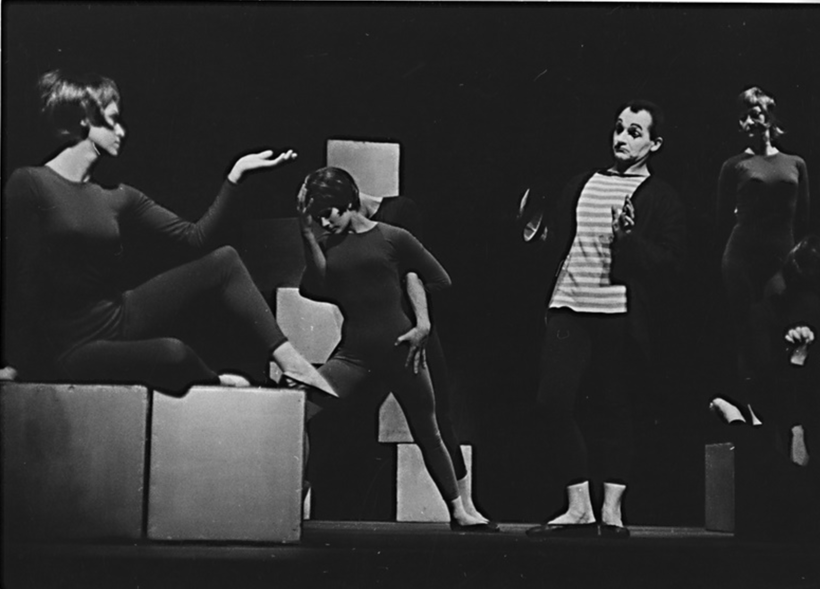Double anniversary of Ladislav Fialka, leading figure of European mime
Thirty years ago, on 22 February, we said goodbye to Ladislav Fialka and shortly after, to his mime group at Divadlo Na Zábradlí (Theatre on the Balustrade). 22 September 2021 will mark 90 years since the birth of the famous mime, whose name is associated with many epithets which originated in the past, such as the “founder of Czech mime”, “creator of Czech mime” or “national” artist. However, over the past years we have oftentimes experienced an odd form of aversion towards the poetics of the mime theatre he created together with the members of the Theatre on the Balustrade mime group and which is often referred to as “Fialka’s mime”.
Even today, we come across these contradictory evaluations, though the field of mime theatre is so curiously diversified and the basic terms no longer define the characteristics of contemporary movement forms. It makes us wonder whether the community of experts has a clear and complex idea of what Ladislav Fialka had to do to resurrect the almost-forgotten genre and how he put the word pantomime back on the list of culture-related expressions. It also begs the question why the work of the Theatre on the Balustrade mime group is so often linked to Fialka’s individual contribution and is not perceived – as it would deserve – in the historical context. It was the social and cultural movements of the years 1958-1991 (Fialka’s active career) that helped shape Czech culture.
Successful start and the impact of the 1950‘s
Remembering Ladislav Fialka, I would like to point out the key moments in the formation of his “founding era”. In the true sense of the word, he was not a restorer of the forgotten art in the post-1945 Czech environment, as he was preceded by Divadlo satiry which hosted a mime performance called Circus naděje (1948) staged by Miroslav Horníček. It was a time of Europe’s growing interest in non-verbal ways of expression, sparked during the war by Marcel Carné’s film Children of Paradise starring Jean-Louis Barrault as Jean Gaspard Deburau. In Czechoslovakia, one of the biggest impulses to ignite the interest in pantomime was František Kožík’s novel Největší z Pierotů (The Greatest Pierrot). Less is known about Horníček’s production which premiered only a year after Marcel Marceau founded his Théâtre de la Poche and started his stellar international career. The Czech theatre culture took a path towards mime art in line with global trends. This line being cut short after the year 1949 is a consequence of the well-known political evolution.
Freeing culture from the trammels of dogmas at the end of the 1950’s meant the young generation of artists could join a new movement, which followed the era of “basement theatres” (during which the young people in neighbouring counties were claiming the right to freedom of opinion and expression). The Czechoslovak little theatre movement was defending the opposition platform, especially against the idle manifestations of socialist realism culture of large theatres. We should not forget that the year 1956, when the political restrains were partially eased, marks the similarly motivated appointment of Otomar Krejča as the director of the National Theatre Drama Department, and Alfréd Radok as the director of Laterna Magika.
In 1956, small musical and theatre groups founded by amateurs were seeing a boom. In that year, a bunch of young dancers left the dance department of the Prague conservatoire to pursue a career in mime. The group of aspiring artists (pupils of Laurette Hrdinová, Ludmila Kovářová, Zdenka Kratochvílová and Jana Tvrzská-Pešková) headed by Ladislav Fialka and including amateur actors and mime artists Richard Weber and Ivan Lukeš, sympathised with the movement of little theatres across genres and shared the same unpretentious desire for normal apolitical life: artistically, the group was connected with one of the most important tendencies of this movement – it represented the marginal, non-verbal outpost of poetic theatres.
Artistic revolt
Like their literary fellow artists, Fialka and his group were striving for a spiritual return of theatre to the life of ordinary people (as they called it: to everyday life), but they did it in an artistically more challenging, poetic way. That was the essence of their artistic revolt against the rigid forms of classical ballet as well as the heroes of Czech and Soviet plays about war, factories and agriculture. Though the Pantomime on the Balustrade’s productions were earning positive feedback and admiration, Ladislav Fialka along with the management of the Theatre on the Balustrade had to fight for the recognition of the “new” theatrical form and ward off the rebukes of hardlined communists who were calling for political engagement of theatres.
Inspired by the Soviet example and the admiration for Marcel Marceau’s work, they eventually acknowledged that the field had its qualities. However, the company had to withstand some pressure, as evidenced by Fialka’s dramaturgy. Besides drawing inspiration from historical forms of drama – such as fair theatre, commedie dell’arte, romantic pantomime, buffoonery and others – he often included themes that imitated obligatory political slogans: hence the much-exploited theme of war and peace.
The “founding years“ also saw an increase in the number of amateur mime theatres and in late 1950’s, Eduard Žlábek and Milan Sládek founded a second mime company under the auspices of Emil František Burian and Nina Jirsíková in the D 34 Theatre. Considering the general evolution inside the field, Ladislav Fialka – a creative force, a socially skilled person and an extremely hard-working man - takes credit for promoting the field on the Czech cultural scene in the years 1959-1969.
In 1962, i.e. the year marking the 1st edition of the International Mine Festival in Berlin, Fialka together with his colleagues and company members became leading figures of European mime; it was the guest performances of the pantomime and drama companies of the Theatre on the Balustrade at the World Theatre Season in the Aldwych Theatre, London (Cesta in 1967 and Blázni in 1968) that earned global fame to the Czech mime. At home, the pantomime company of the Theatre on the Balustrade was already recognised as part of Czech theatre avant-guard. Two editions of Prague International Mime Festival (1969 and 1971) were a mere residue of the company’s previous efforts and drive.
Important productions
The question is how much today’s cultural public knows Fialka’s work, especially from his heyday in the first decade of the company’s existence. I remember very well the sparkling freshness, wit and surprising diversity of his creations, including the elegance and movement quality. Not only did he use some lovely historical themes and forms which had been previously neglected by theatre makers, but he also created supremely compelling images from the life of an ordinary human being; the characters such as Pierrot the servant, Columbine the chamber maid, the senile and mean Dottore, the dumb lover Capitan live their ordinary lives, and experience love as well as trouble.
Inspired by generally used types of characters, the company members – all of them brilliant performers - came up with their own modern variations required by the diverse repertoire. Initially, they built on the Dalcroz-Laban technique they learned at the conservatoire. Soon they incorporated the principles of Marcel Marceau’s imaginary poetics and his theatrical form of Decroux’s pure mime. Proportionally to the rich and varied repertoire, the company members were looking for their own distinct approach to characters but they had the same technical background and training, which played a key role in maintaining the purity of style.
Originally, it was Ladislav Fialka who stood in the limelight. In the Theatre on the Balustrade’s first production (1958) called Kdyby tisíc klarinetů (If a Thousand clarinets) he was the only mime playing Motýlek (Butterfly) and Život člověka (Life of a Human), while the girls (Ludmila Kovářová and Zdenka Kratochvílová) were “only” dancing. However, his fellow artists made so much progress under his leadership that English festival critics pointed out the excellent qualities of Richard Weber, Ludmila Kovářová, Zdenka Kratochílová and Jana Pešková, saying that Ladislav Fialka is not the only “star” in the show.
He also began to rely on his colleagues‘ creativity and as a director, he would give them a lot of space. To this day, the productions of Pantomima na zábradlí (Pantomime on the Balustrade, 1959), Devět klobouků na Prahu (Nine hats in Prague, 1960), Etudy (Studies, 1960), Cesty (The Way, 1962), Blázni (Fools, 1965) and Knoflík (The Button, 1968) remain the most original contributions to the history of Czech theatre for their relentless search for original expressive means, their high technical level and the interpretative development of the company members. The communicative and outgoing director of the pantomime company of the Theatre on the Balustrade was able to react to impulses coming from close proximity or from far away and he responded to the major issues of his time in his own original way – as is apparent from his outstanding mime adaptations of Kafka’s works, such as The Trial, Metamorphosis and The Story of Mr K.
Second wave
Changes in political climate during the Soviet occupation had an impact on the whole society. It also effected the mentality of the audience. They enthusiastically welcomed a new kind of mime art presented by the young generation, namely Ctibor Turba, Boris Hybner from The Alfréd Jarry Pantomime and Boleslav Polívka from the Na provázku Theatre. On the one hand, it was a creative outburst of the artistic opposition whose expressive means drew from silent slapstick comedies and absurd theatre. On the other hand, they brought new kind of content in productions such as Harakiri (1968), Turba tacet aneb udělej mu to zprava (1970) or Am a Ea (1973) which worked with the motifs of clown show and circus. The way they reacted to contemporary social situation was unparalleled (save for Bohumil Hrabal’s works).
The difference between the founding concept of pantomime and its second wave was grounded in dramaturgy: Fialka‘s The Button was a poetic and melancholic contemplation on the ups and downs of one‘s artistic life. Its protagonist, played by Ladislav Fialka, walks the path from humble beginnings to success and a nostalgic fall from glory. On a shabby stage, Turba and Hybner performed a black comedy about ragged and rough old men, spending their late years doing petty quarrels, and added scenes full of nonsense and surrealist images of cruelty as well as metaphoric reminiscence of militarist practices of French offices (accompanied by expressive music of Russian origin, e.g. a coo-coo game). The immense topicality of the Alfréd Jarry Pantomime, including the radical diversion from the poetic language of imaginary mime, is beyond doubt.
Both post-1968 editions of the International Mime Festival (the last one taking place in a fairly tense atmosphere) confirmed the international prestige of Fialka’s company and most importantly, they provided Czech audiences with the opportunity to see the most prominent international mime artists, from French to Japanese (thanks to Ladislav Fialka, director Vladimír Vodička, theatre critic Dana Paseková and the director of the Theatre Institute Eva Soukupová). The honorary chairmen were such legends as Samuel Beckett, Jean-Louis Barrault and Mary Wigman. However, the post-1972 cultural isolation and political purges paralysed the effect of these events.
Illusion of uniqueness
Ladislav Fialka managed to react to the new situation by a piece called Caprichos (1971), in which he tackled the theme of fear and death through many metaphors. But his Hry (Plays, 1976), a formally pure physical theatre piece based on Samuel Beckett and Eugen Ionesco’s work, was lagging behind the era of absurd theatre which was topical for the drama company of the Theatre on the Balustrade many years prior. The piece called Lásky (Loves, 1974), though, was a non-binding, playful picture of daily life; the interest in mime art was shifting elsewhere.
In the time when the greatest personalities of Czech theatre were silenced (a ban for Za branou Theatre and the State Theatre Studio, Alfréd Radok’s emigration etc.), many young artists with unproblematic dossiers enjoyed relative freedom, provided they lived in poverty and on the edge of society. These productions (of the White Theatre, Alfred Theatre, Křesadlo, Cvoky, the mime pieces by the Na provázku Theatre such as Trosečník/Castaway,) focused on topics rarely adapted for dance, such as emotional and mental distress or a ritual, formally often under the influence Jerzy Grotowski’s “poor theatre”. The culmination of these efforts came at the end of the 1980’s with Deklaunizace (1986) by Ctibor Turba. Compared to these ground-breaking and often oppositionist works, the creations of the Theatre on the Balustrade mime group started to feel old-fashioned, e.g. Funambules 77 (1977), Noss (1981) or Sny (Dreams, 1985). It was probably because the state wanted Czech theatre to be represented by an unproblematic non-verbal art. This brought official recognition to Ladislav Fialka, the National Artist, and existential security and illusion of uniqueness to the company members, but their ties with the life at home were cut. Moreover, the company underwent generational renewal, but it did not bring any revolution.
In the late 1980’s, Fialka’s Prague premieres were mostly attended by international audiences. When he collaborated as a choreographer with the Theatre on the Balustrade drama company and Evald Schorm on productions of Na laně přes Niagaru (Walking a Tightrope over Niagara Falls, 1976) and Maratón (Marathon, 1980), this activity had little impact of the artistic profile of his mime company. Critics commented on the collaboration using an ironic statement: “Beggars can’t be choosers.” The privileged position of Fialka’s mime inside the 1980’s and 1970’s complex artistic practice led to isolation (save for a few cases) because the company found excluded from the unofficial but roaring cultural life. It was partly due to the political situation of the day, which to some extent exploited Ladislav Fialka’s fame.
However, Ladislav Fialka was not as artistically paralysed as might seem, considering his late 1980’s creations. He was able to return to the most serious topic of his creative period – after the Velvet Revolution he decided to stage his Poutník (Wanderer, 1991), in which he could open again the theme of Kafka’s Trial. His sudden death, though, halted the preparations of the production.
Popularisation of mime
One of the main contributions of Fialka‘s work to the Czech culture is his activities which go in two directions. Firstly, as the only one of the leading personalities of mime theatre, he was continuously striving for popularization of himself as an artist, but also for popularisation of mime as a specific art form. During his early career, he delivered public lectures in the municipal library, presenting the almost-forgotten art in an attractive way, using film excerpts and short videos. In his 1964 book Umění pantominy (The Art of Mime, published by Naše vojsko), he looked at mime from a world perspective while explaining his own mime poetics. Later, as a teacher at the Music and Dance Faculty of the Academy of Performing Arts, he edited a university textbook entitled Pantomima, containing studies by various authors on the key phases in the evolution of mine.
In cooperation with the Slovak Television Bratislava and the film studio Wildbad Schwarzwald from the Federal Republic of Germany, he shot an exceptional and still attractive TV series Mimstory (1988), together with Marcel Marceau and the Israeli artist Samy Molcho. He appeared in many promotional short films and TV gags. He supported the foundation of the bygone exposition about Jean Gaspard Deburau and Czech mime art in the Kolín museum, and he equally popularised the research by Jaroslav Švehla who published several studies on the same topic.
Secondly, Ladislav Fialka takes credit for establishing a system of mime education. He was well aware that the existing elaborate methods had to be maintained and that it was necessary to organise them into a coherent and complete system. Unfortunately, his personal archive is not open yet so we do not know whether he penned down his ideas. What we can access, though, is the 1963 film recording by Radúz Činčera called Studie I. and II. Fialka also realized his educational visions by organising international summer mime workshops. In 1974, he became head of the section Choreography of Pantomime at HAMU, and thus allowed his successors to provide systemised education to aspiring artists at the independent Department of Non-verbal Theatre.




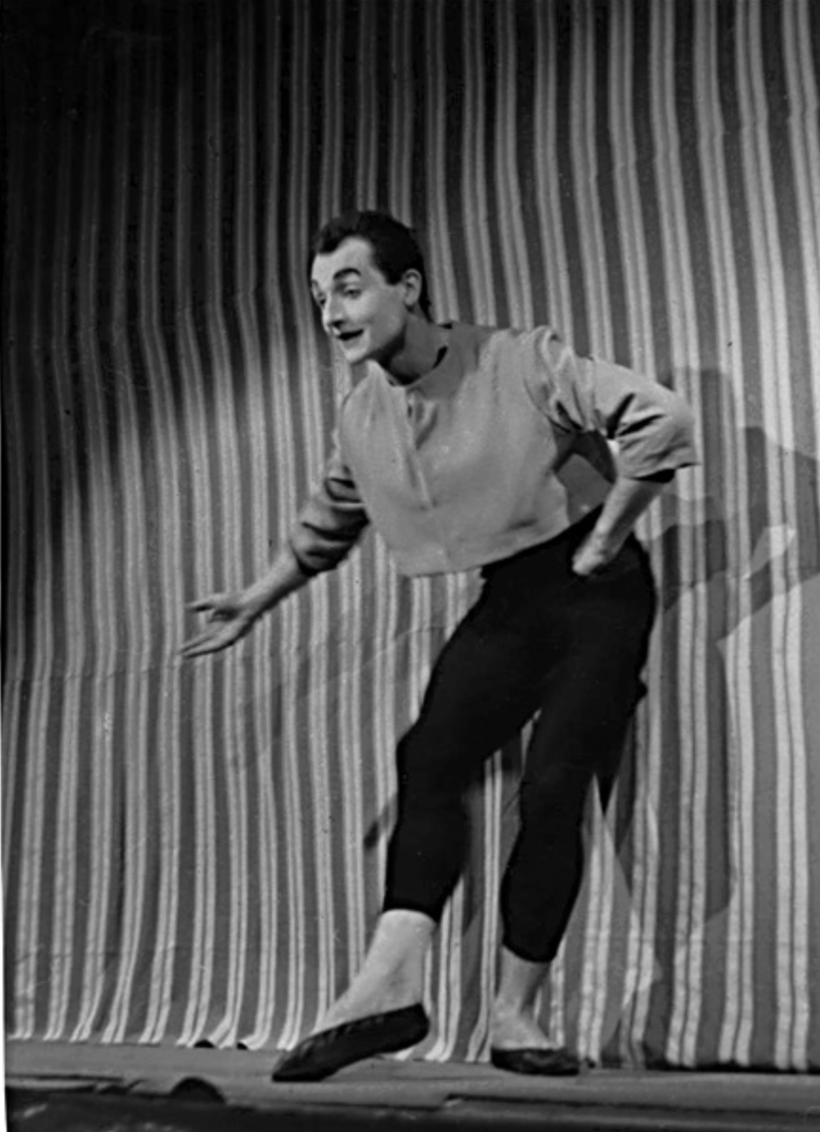. Foto_ Jaroslav Kuna. Zdroj_ IDU..png)
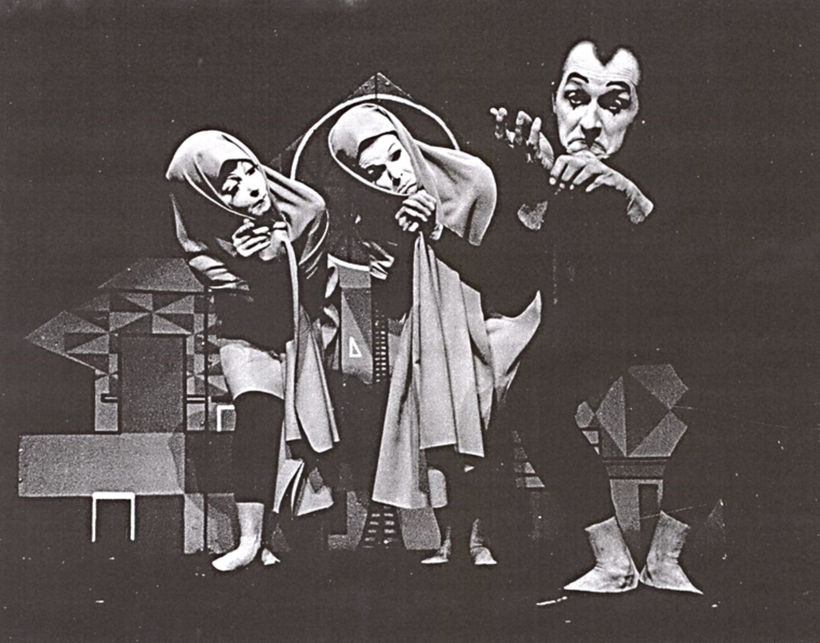. Zdroj_ IDU..png)
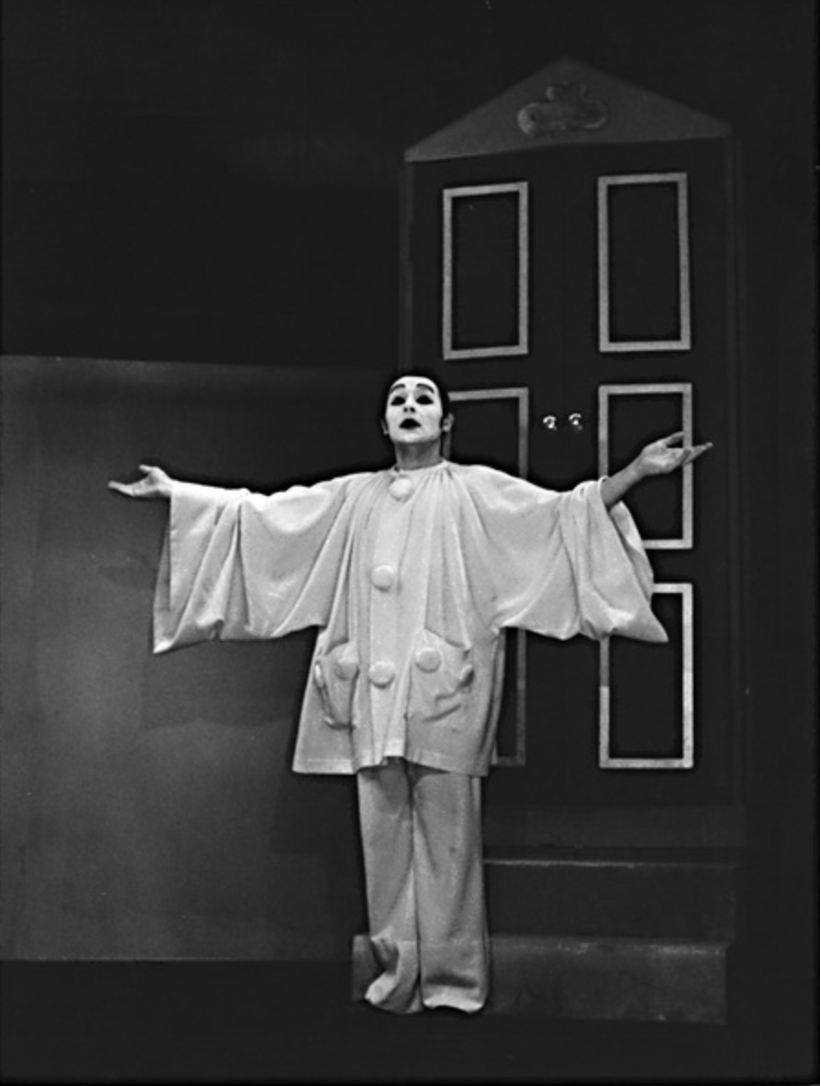. Zdroj_ IDU.2.png)
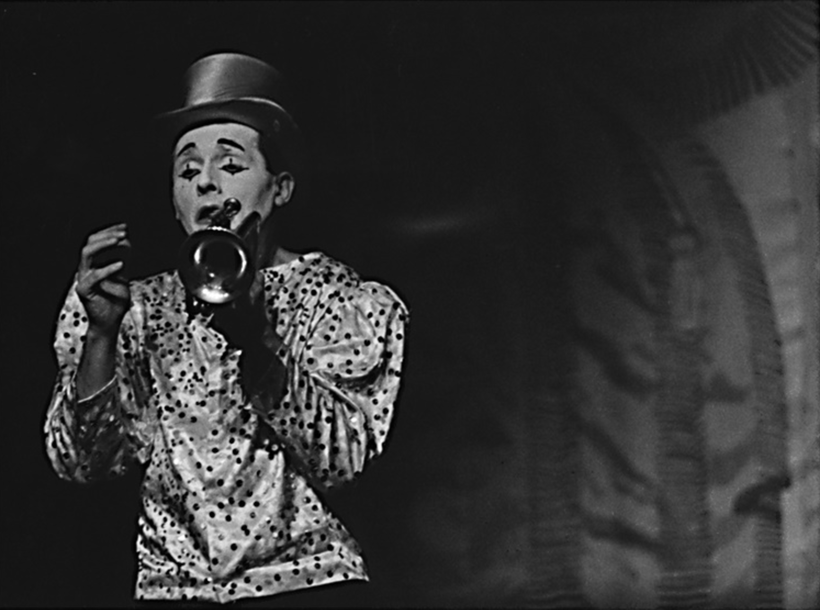. Foto_ Jaroslav Kuna. Zdroj_ IDU..png)
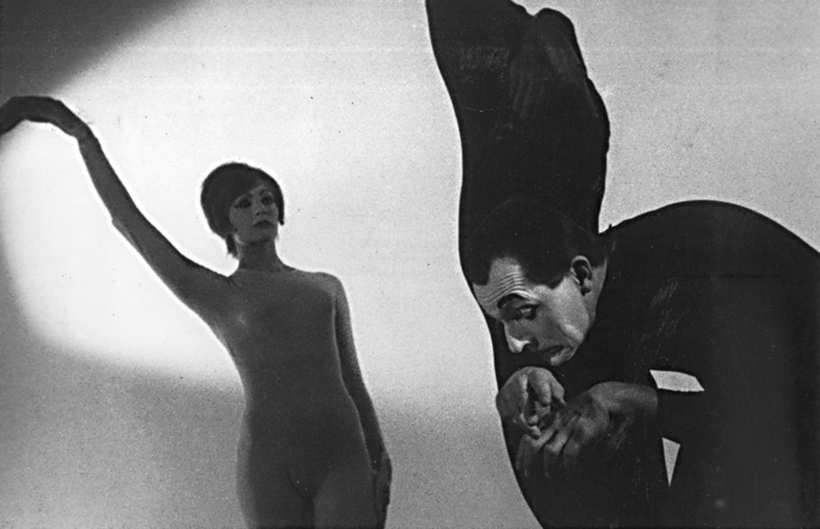. Foto_ Jaroslav KrejcÌ_iÌ_. Zdroj_ IDU..png)
